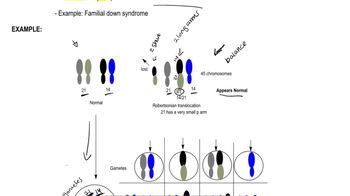Here are the essential concepts you must grasp in order to answer the question correctly.
Cri-du-chat Syndrome
Cri-du-chat syndrome is a genetic disorder caused by a deletion of a portion of chromosome 5, specifically at the 5p15.2 locus. This condition is characterized by distinctive features such as a high-pitched cry resembling that of a cat, developmental delays, and various physical abnormalities. Understanding the genetic basis of this syndrome is crucial for assessing the risk of recurrence in future pregnancies.
Recommended video:
Robertsonian Translocations
Karyotype Analysis
Karyotype analysis is a laboratory technique used to visualize an individual's chromosomes, allowing for the identification of chromosomal abnormalities such as deletions, duplications, or translocations. In this case, analyzing the karyotypes of the parents and the affected child can help determine whether the deletion is de novo (new) or inherited, which is essential for calculating the probability of recurrence in future offspring.
Recommended video:
Recurrence Risk
Recurrence risk refers to the probability that a genetic disorder will occur again in future offspring of the same parents. This risk can be influenced by factors such as the mode of inheritance, parental carrier status, and the presence of chromosomal abnormalities. In the context of cri-du-chat syndrome, understanding whether the deletion is inherited or new will significantly impact the estimated risk for subsequent children.
Recommended video:
 Verified step by step guidance
Verified step by step guidance Verified video answer for a similar problem:
Verified video answer for a similar problem:

